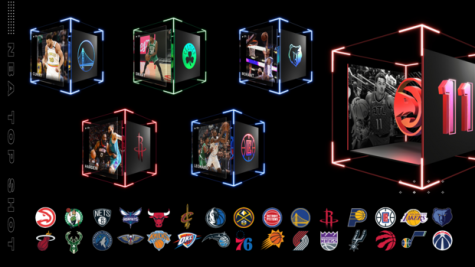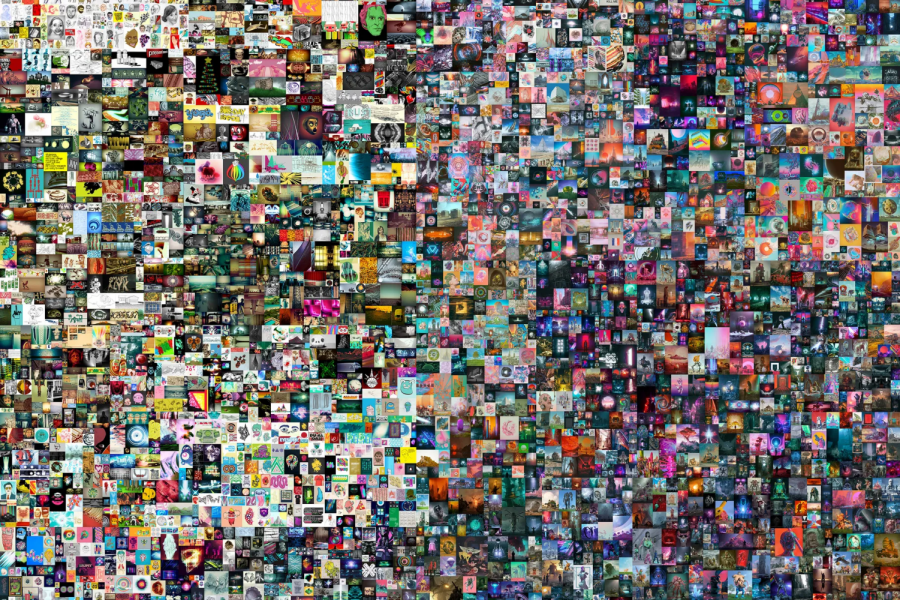NFTs, Blockchain Technology Taking the Art World by Storm
May 25, 2021
On March 11, 2021, Mike Winklemann, the digital artist known as “Beeple,” marked the groundbreaking record of selling his art piece, “EVERYDAYS: THE FIRST 5000 DAYS,” for 69 million U.S. dollars. In the final 30 minutes of the auction, the price for his unique digital art, which consisted of a massive collage of 5000 pieces of work Beeple has released on the internet for over 13 and a half years, jumped from $15 million to $69 million. Now, Beeple’s pieces are leading the crypto-art boom as digital tokens known as NFTs gain popularity in the midst of the COVID-19 pandemic.
So what is NFT? NFT, an abbreviation for “non-fungible token,” is a digital asset that operates as a collector’s item and cannot be duplicated. In other words, an NFT is a unique proof of ownership over anything digital such as drawings, videos, and music. Purchasing an NFT gives the purchaser a certificate of ownership over a digital object, protecting its value. This does not mean that the purchaser is getting the copyright or trademark to the item and does not guarantee that there would be no other versions of the item on the internet. Still, buying an NFT has become very popular and incredibly valuable. Jake Brukhman, the founder of cryptocurrency investment company CoinFund, said, “You’re not buying the picture….You’re buying the property rights to the picture.”
With the NFT boom during the pandemic, anything can be turned into this rising type of technology and fetch thousands and millions of dollars (if you’re lucky). It is unsurprising that there have been more than a few bizarre digital pieces sold as NFTs. In early March, a technology company called Injective Protocol bought a Banksy print titled Morons (White) for $95,000 in Brooklyn. Then, the company set up a stunt where masked men set fire to the print for the sole purpose of turning Banksy’s work into an NFT and quadrupling its value. Their approach proved to be successful. In fact, the NFT of the live stream was sold for $382,336. Injective Protocol executive Mirza Uddin spoke to The Guardian, “We specifically chose a Banksy piece since he has previously shredded one of his own artworks at an auction.”

Large corporations have also started to launch NFTs for profit and publicity. The NBA recently launched Top Shot, a block-chain-based platform where video clips of game highlights are on sale. These clips’ prices vary depending on the rarity, and they all come in NFT format, and fans collect them and trade them for tens of thousands of dollars.
Aside from digital art, the very first tweet on Twitter made by the Twitter founder Jack Dorsey, “just setting up my twttr,” was sold as an NFT on Monday,  March 22, for about $2.9 million. Similarly, Nyan Cat, the viral internet meme in 2011 depicting a pixelated Pop Tart-bodied cat with a rainbow tail, was sold for about $580,000. The Nyan Cat’s creator Chris Torres told The New York Times in late February 2021, “I feel like I’ve opened the floodgates.”
March 22, for about $2.9 million. Similarly, Nyan Cat, the viral internet meme in 2011 depicting a pixelated Pop Tart-bodied cat with a rainbow tail, was sold for about $580,000. The Nyan Cat’s creator Chris Torres told The New York Times in late February 2021, “I feel like I’ve opened the floodgates.”
While the history of digital art dates back to the mid-1960s, its simplicity for anyone to easily duplicate made it difficult to assign the origin and the worth of the piece. Today, with the recent introduction of NFTs, both the artists and collectors are able to validate the authenticity and the warranted ownership of the digital artwork.
Source:
- https://www.businessofbusiness.com/articles/crypto-art-nft-beeple-christies-auction-token-ethereum-dada-blockchain/
- https://www.forbes.com/sites/cathyhackl/2021/03/04/four-things-brands-need-to-know-about-nfts-non-fungible-tokens/?sh=2944b7db222f
- https://www.forbes.com/sites/vipinbharathan/2021/02/21/non-fungible-token-art-market-gets-boost-with-christies-upcoming-auction/?sh=7b4d3a52fc70
- https://www.nytimes.com/2021/02/22/business/nft-nba-top-shot-crypto.html

